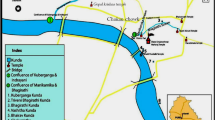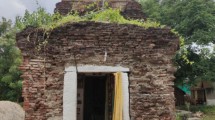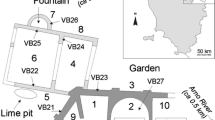Abstract
The present study characterizes mortars from Thanjavur Palace (Thanjavur, India) to illustrate ancient production methods and the raw materials used. The mineralogical-petrographic composition of mortars was determined using optical microscopy, supported by scanning electron microscopy with energy-dispersive spectroscopy and X-ray powder diffraction. The chemical composition and organic content of the binder were also determined. The aggregate-binder ratio and particle size distribution of the mortars were investigated. Results showed that the composition of both the aggregate and binder varied between mortars. The aggregate consisted mainly of quartz, with small quantities of feldspar and individual grains of limestone and other lithic grains present. The majority of the mortars contained a lime binder, but kaolinite was also identified, indicating a clay binder. Kaolinite primarily occurred in bedding mortars rather than plaster mortars. All samples were in a deteriorated state due to the presence of gypsum and halite. Analysis of particle size distribution confirmed the size of the aggregates to range between 1.18 and 0.3 mm, showing that the aggregates must have been ground in order to allow for the dispersion of binders. Furthermore, biomolecules in the form of carbohydrates, proteins and fats, which could serve as natural admixtures to improve properties in both the fresh and hardened state, were identified in all mortar samples.










Similar content being viewed by others
Data availability
This manuscript has associated data in a data repository. [Authors’ comment: This manuscript has no associated data or the data will not be deposited.]
References
D. Carran, J. Hughes, A. Leslie, C. Kennedy, A short history of the use of lime as a building material beyond Europe and North America. Int. J. Architect. Heritage 6(2), 117–146 (2012). https://doi.org/10.1080/15583058.2010.511694
R.P.J. Van Hees, L. Binda, I. Papayianni, E. Toumbakari, Characterisation and damage analysis of old mortars. Mater. Struct. 37(273), 644–648 (2004)
A. Arizzi, G. Cultrone, Aerial lime-based mortars blended with a pozzolanic additive and different admixtures: a mineralogical, textural and physical-mechanical study. Constr. Build. Mater. 31, 135–143 (2012). https://doi.org/10.1016/j.conbuildmat.2011.12.069
I. Papayianni, M. Stefanidou, Durability aspects of ancient mortars of the archeological site of Olynthos. J. Cult. Herit. 8(2), 193–196 (2007). https://doi.org/10.1016/j.culher.2007.03.001
A. Moropoulou, A. Bakolas, S. Anagnostopoulou, Composite materials in ancient structures. Cem. Concr. Compos. 27(2), 295–300 (2005). https://doi.org/10.1016/j.cemconcomp.2004.02.018
S. Sánchez-Moral, L. Luque, J.C. Canaveras, V. Soler, J. Garcia-Guinea, A. Aparicio, Lime–pozzolana mortars in Roman catacombs: composition, structures and restoration. Cement Concr. Res. 35(8), 1555–1565 (2005). https://doi.org/10.1016/j.cemconres.2004.08.009
M.D. Jackson, S.R. Chae, S.R. Mulcahy, C. Meral, R. Taylor, P. Li, A.H. Emwas, J. Moon, S. Yoon, G. Vola, H.R. Wenk, Unlocking the secrets of Al-tobermorite in Roman seawater concrete. Am. Miner. 98(10), 1669–1687 (2013). https://doi.org/10.2138/am.2013.4484
M.D. Jackson, J. Moon, E. Gotti, R. Taylor, S.R. Chae, M. Kunz, A.H. Emwas, C. Meral, P. Guttmann, P. Levitz, H.R. Wenk, Material and elastic properties of Al-tobermorite in ancient Roman seawater concrete. J. Am. Ceram. Soc. 96(8), 2598–2606 (2013). https://doi.org/10.1111/jace.12407
M.D. Jackson, S.R. Mulcahy, H. Chen, Y. Li, Q. Li, P. Cappelletti, H.R. Wenk, Phillipsite and Al-tobermorite mineral cements produced through low-temperature water-rock reactions in Roman marine concrete. Am. Miner. 102(7), 1435–1450 (2017). https://doi.org/10.2138/am-2017-5993CCBY
S. Kramar, V. Zalar, M. Urosevic, W. Körner, A. Mauko, B. Mirtič, J. Lux, A. Mladenović, Mineralogical and microstructural studies of mortars from the bath complex of the Roman villa rustica near Mošnje (Slovenia). Mater. Charact. 62(11), 1042–1057 (2011). https://doi.org/10.1016/j.matchar.2011.07.019
E. Uğurlu, H. Böke, The use of brick–lime plasters and their relevance to climatic conditions of historic bath buildings. Constr. Build. Mater. 23(6), 2442–2450 (2009). https://doi.org/10.1016/j.conbuildmat.2008.10.005
P. Maravelaki-Kalaitzaki, A. Bakolas, I. Karatasios, V. Kilikoglou, Hydraulic lime mortars for the restoration of historic masonry in Crete. Cement Concr. Res. 35(8), 1577–1586 (2005). https://doi.org/10.1016/j.cemconres.2004.09.001
H. Böke, S. Akkurt, B. İpekoğlu, E. Uğurlu, Characteristics of brick used as aggregate in historic brick-lime mortars and plasters. Cement Concrete Res. 36(6), 1115–1122 (2006). https://doi.org/10.1016/j.cemconres.2006.03.011
P. Vitruvius, Ten books on architecture. (Translation by Ingrid D. Rowland, 2001).
E. Vejmelková, M. Keppert, P. Rovnaníková, Z. Keršner, R. Černý, Application of burnt clay shale as pozzolan addition to lime mortar. Cement Concr. Compos. 34(4), 486–492 (2012). https://doi.org/10.1016/j.cemconcomp.2012.01.001
L.B. Sickels, Mortars in Old buildings and in Masonry conservation: a historical and practical treatise (Doctoral dissertation, The University of Edinburgh (United Kingdom)) (1988)
D.S. Mitchell, The use of lime and cement in traditional buildings (2007)
F. Yang, B. Zhang, C. Pan, Y. Zeng, Traditional mortar represented by sticky rice lime mortar—one of the great inventions in ancient China. Sci. China Ser. E: Technol. Sci. 52(6), 1641–1647 (2009). https://doi.org/10.1007/s11431-008-0317-0
F. Yang, B. Zhang, Q. Ma, Study of sticky rice−lime mortar technology for the restoration of historical masonry construction. Acc. Chem. Res. 43(6), 936–944 (2010). https://doi.org/10.1021/ar9001944
C. Fiori, M. Vandini, S. Prati, G. Chiavari, Vaterite in the mortars of a mosaic in the Saint Peter basilica, Vatican (Rome). J. Cult. Heritage 10(2), 248–257 (2009). https://doi.org/10.1016/j.culher.2008.07.011
Y. Zeng, B. Zhang, X. Liang, A case study and mechanism investigation of typical mortars used on ancient architecture in China. Thermochim. Acta 473(1–2), 1–6 (2008). https://doi.org/10.1016/j.tca.2008.03.019
S. Fang, H. Zhang, B. Zhang, G. Li, A study of Tung-oil–lime putty—a traditional lime-based mortar. Int. J. Adhesion Adhesives 48, 224–230 (2014). https://doi.org/10.1016/j.ijadhadh.2013.09.034
C. Nunes, Z. Slížková, Hydrophobic lime-based mortars with linseed oil: characterization and durability assessment. Cem. Concr. Res. 61, 28–39 (2014). https://doi.org/10.1016/j.cemconres.2014.03.011
L. Ventolà, M. Vendrell, P. Giraldez, L. Merino, Traditional organic additives improve lime mortars: new old materials for restoration and building natural stone fabrics. Constr. Build. Mater. 25(8), 3313–3318 (2011). https://doi.org/10.1016/j.conbuildmat.2011.03.020
S. Thirumalini, Heritage lime mortar characterisation and simulation (2015)
R. Ravi, S. Thirumalini, N. Taher, Analysis of ancient lime plasters–Reason behind longevity of the Monument Charminar, India a study. J. Build. Eng. 20, 30–41 (2018). https://doi.org/10.1016/j.jobe.2018.04.010
A.S. Nene, Building materials and construction techniques of ancient India. New Delhi, India, Ganga (2012)
S. Chandra, History of Architecture and Ancient Building Materials in India: Part I & Part II (in Single Volume) (Tech Books Int, New Delhi, 2003)
S. Pradeep, T. Selvaraj, Identification of bio-minerals and their origin in lime mortars of ancient monument: Thanjavur Palace. Int. J. Architect. Heritage 15(3), 426–436 (2019). https://doi.org/10.1080/15583058.2019.1623341
F.M. León-Martínez, P.D.J. Cano-Barrita, F. Castellanos, K.B. Luna-Vicente, S. Ramírez-Arellanes, C. Gómez-Yáñez, Carbonation of high-calcium lime mortars containing cactus mucilage as additive: a spectroscopic approach. J. Mater. Sci. 56(5), 3778–3789 (2021). https://doi.org/10.1007/s10853-020-05514-5
S. Thirumalini, R. Ravi, S.K. Sekar, M. Nambirajan, Knowing from the past–ingredients and technology of ancient mortar used in Vadakumnathan temple, Tirussur, Kerala, India. J. Build. Eng. 4, 101–112 (2015). https://doi.org/10.1016/j.jobe.2015.09.004
B. Middendorf, J.J. Hughes, K. Callebaut, G. Baronio, I. Papayianni, Investigative methods for the characterisation of historic mortars—part 2: chemical characterisation. Mater. Struct. 38(8), 771–780 (2005). https://doi.org/10.1007/BF02479290
E.C. Eckel, Cements, Limes and Plaster (Routledge, 2015)
H.F. Taylor, Cement Chemistry, vol. 2 (Thomas Telford, London, 1997)
IS:2386 (Part I)—1975. Method of Test for Aggregate and Concrete-Particle Size and Shape. Bureau of Indian Standard, New Delhi, India (1991)
IS:7874 (Part I)—1975. Methods of Tests for Animal Feeds and Feeding Stuffs. Bureau of Indian Standard, New Delhi, India (1991)
K.M. Haneefa, S.D. Rani, R. Ramasamy, M. Santhanam, Microstructure and geochemistry of lime plaster mortar from a heritage structure. Constr. Build. Mater. 225, 538–554 (2019). https://doi.org/10.1016/j.conbuildmat.2019.07.159
V. Selvakumar, Prehistoric and historical archaeology of the lower Kaviri Valley and Pudukottai Region, Tamil Nadu, in Proceedings of the Indian History Congress, vol 69, (2008), pp. 1015–1023 (2008). Indian History Congress. https://www.jstor.org/stable/44147262
B. Lubelli, T.G. Nijland, R.P.J. Van Hees, Self-healing of lime-based mortars: microscopy observations on case studies. Heron 56 (1/2) (2011)
J.M.P.Q. Delgado, A.S. Guimarães, V.P. De Freitas, I. Antepara, V. Kočí, R. Černý, Salt damage and rising damp treatment in building structures. Adv. Mater. Sci. Eng. (2016). https://doi.org/10.1155/2016/1280894
O. Cazall, C. Rodriguez-Navarro, E. Sebastian, G. Cultrone, M.J. De la Torre, Aging of lime putty: effects on traditional lime mortar carbonation. J. Am. Ceramic Soc. 83(5), 1070–1076 (2000). https://doi.org/10.1111/j.1151-2916.2000.tb01332.x
K. Elert, C. Rodriguez-Navarro, E.S. Pardo, E. Hansen, O. Cazalla, Lime mortars for the conservation of historic buildings. Stud. Conserv. 47(1), 62–75 (2002). https://doi.org/10.1179/sic.2002.47.1.62
G. Cultrone, E. Sebastián, M.O. Huertas, Forced and natural carbonation of lime-based mortars with and without additives: mineralogical and textural changes. Cem. Concr. Res. 35(12), 2278–2289 (2005). https://doi.org/10.1016/j.cemconres.2004.12.012
A. Moropoulou, A. Cakmak, K.C. Labropoulos, R. Van Grieken, K. Torfs, Accelerated microstructural evolution of a calcium-silicate-hydrate (CSH) phase in pozzolanic pastes using fine siliceous sources: comparison with historic pozzolanic mortars. Cement Concrete Res. 34(1), 1–6 (2004). https://doi.org/10.1016/S0008-8846(03)00187-X
R. Ravi, S. Thirumalini, Effect of natural polymers from cissus glauca roxb on the mechanical and durability properties of hydraulic lime mortar. Int. J. Architect. Heritage 13(2), 229–243 (2019). https://doi.org/10.1080/15583058.2018.1431732
R. Ramadoss, A. Ahamed, T. Selvaraj, Alternative approach for traditional slaking and grinding of air lime mortar for restoration of heritage structures: natural polymer. J. Architect. Eng. 25(3), 04019017 (2019). https://doi.org/10.1061/(ASCE)AE.1943-5568.0000361
S. Jayasingh, T. Selvaraj, Effect of natural herbs on hydrated phases of lime mortar. J. Architect. Eng. (2020). https://doi.org/10.1061/(ASCE)AE.1943-5568.0000420
Acknowledgements
The authors acknowledge financial support from the Slovenian Research Agency (research core funding No. P2−0273 and P1-0195)
Author information
Authors and Affiliations
Corresponding author
Ethics declarations
Conflict of interest
No potential conflict of interest was reported by the authors.
Rights and permissions
About this article
Cite this article
Dolenec, M., Dolenec, S., Saridhe, S.P. et al. Inputs to produce lime mortar for conservation and restoration of Thanjavur Palace, India: characterization study. Eur. Phys. J. Plus 136, 929 (2021). https://doi.org/10.1140/epjp/s13360-021-01897-9
Received:
Accepted:
Published:
DOI: https://doi.org/10.1140/epjp/s13360-021-01897-9




